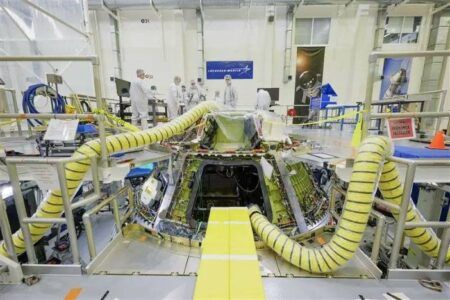A NASA team moved a step closer to building a completely 3D printed, high-performance rocket engine by manufacturing complex engine parts and test firing them together with cryogenic liquid hydrogen and oxygen to produce 20,000 lb of thrust.
Additive manufacturing, or 3D printing, is a key technology for enhancing space vehicle designs and manufacturing and enabling more affordable exploration missions. The technology has the potential to influence spacecraft built for leaving Earth and spaceships and landers for visiting other destinations. Future plans include performing engine tests with liquid oxygen and methane-key propellants for Martian landers since methane and oxygen production might be possible on Mars.
About 75% of the parts needed to build a 3D printed rocket engine have been made into a unit which was tested at NASA’s Marshall Space Flight Center in Huntsville, Alabama, USA.
The Marshall team has been working for the past three years with various vendors to make 3D printed turbopumps and injectors, but until now has tested them individually. The important test was connecting the parts to work in the same manner as in a real engine despite not being packaged together in a configuration that looks like the typical engine you might see on a test stand.
“This is called a breadboard engine,” explained Nick Case, the testing lead for the effort. “What matters is that the parts work the same way as they do in a conventional engine and perform under the extreme temperatures and pressures found inside a rocket engine. The turbopump got its ‘heartbeat’ racing at more than 90,000rpm and the end result is the flame you see coming out of the thrust chamber to produce over 20,000 lb of thrust, and an engine like this could produce enough power for an upper stage of a rocket or a Mars lander.”
Seven tests were performed with the longest tests lasting 10 seconds. During these trials, the 3D printed breadboard engine experienced all the extreme environments inside a flight rocket engine where fuel is burned at temperatures greater than 6,000°F (3,315°C) to produce thrust. The turbopump delivers the fuel in the form of liquid hydrogen cooled to -400°F (-240°C). These tests were performed with cryogenic liquid hydrogen and liquid oxygen, propellants that are mainstays of spaceship propulsion systems. Even if methane and oxygen prove to be the Mars propellant of choice, the propellant combination of cryogenic liquid hydrogen and oxygen tests the limits of 3D printed hardware because it produces the most extreme temperatures and exposes parts to cryogenic hydrogen, which can cause embrittlement.
In addition to testing with methane, the team plans to add other key components to the demonstrator engine including a cooled combustion chamber and nozzle and a turbopump for liquid oxygen.
Using layering of metal powder fused together with a laser –selective laser melting – the 3D printed turbopump had 45% fewer parts than those made with traditional manufacturing methods. The injector had over 200 fewer parts than traditionally manufactured injectors, and it incorporated features that have never been used before because they are only possible with additive manufacturing.
January 8, 2016




